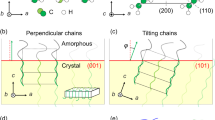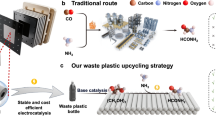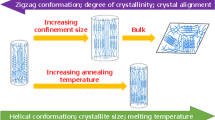Abstract
We studied the elongational crystallization of poly(ethylene terephthalate) (PET) from the melt using polarizing optical microscope and X-ray observation. We verified that the structure and morphology discontinuously changed from conventional stacked lamellae of folded chain crystals (FCCs) to nano-oriented crystals (NOCs) when the elongational strain rate (\(\dot \varepsilon \)) exceeded a critical value of \((\dot \varepsilon ^*) \cong 10^2\,{\mathrm{s}}^{ - 1}\). Therefore, the universality of NOC formation was verified. We found that the NOCs of PET show a novel three-dimensional (3D) structure and morphology: (i) nanocrystals (NCs) were arranged in a monoclinic lattice, which is a specific morphology for NOCs of PET, compared to iPP, and (ii) the unit cell structure of NOCs was a triclinic system with biaxial orientation. We showed the important role of the primary structure of the plate, such as a benzene ring, in the formation of a novel 3D structure and the morphology of the NOCs of PET. We also clarified that the NOCs of PET showed high performance, such as a high heat resistance temperature (Th)\(\ \cong\ \)281 °C, a high melting temperature (Tm)\(\ \cong\ \)285 °C, high maximum tensile stresses for the machine direction (MD) and transverse direction (TD)\(\ \cong\ \)2.8 × 102 and 74 MPa, respectively, and high Young’s moduli for MD and TD \(\ \cong\ \)5.4 and 1.7 GPa, respectively.
Similar content being viewed by others
Log in or create a free account to read this content
Gain free access to this article, as well as selected content from this journal and more on nature.com
or
References
Okada K, Washiyama J, Watanabe K, Sasaki S, Masunaga H, Hikosaka M. Elongational crystallization of isotactic polypropylene forms nano-oriented crystals with ultra-high performance. Polymer J. 2010;42:464–73.
Kakudo M, Kasai N. Kobunshi xsen kaisetsu. Tokyo, Japan: Maruzen publishing Co. Ltd.; 1968. p. 75–96.
Okada K, Tagashira K, Sakai K, Masunaga H, Hikosaka M. Temperature dependence of crystallization of nano-oriented crystals of iPP and the formation mechanism. Polymer J. 2013;45:70–8.
Price FP. Nucleation. In: Zettlemoyer AC, editor. Ch. 8. New York, NY: Marcel Dekker Inc.; 1969.
Daubeny R, de P, Bunn CW, Brown CJ. The crystal structure of polyethylene terephthalate. Proc R Soc Lond. 1954;A226:531–42.
Ikeda M, Mitsuishi Y. Studies on thermal behavior and fine structure of polyethylene-terephthalate. I. Equilibrium melting temperature and surface free energy. Koubunshi Kagaku. 1967;24:378–84.
Fakirov S, Fischer EW, Hoffmann R, Schmidt GF. Structure and properties of poly(ethylene terephthalate) crystallized by annealing in the highly oriented state: 2. Melting behavior and the mosaic block structure of the crystalline layers. Polymer. 1977;18:1121–9.
Mehta A, Gaur U, Wunderlich B. Equilibrium melting parameters of poly(ethylene terephthalate). J Polymer Sci Polymer Phys. 1978;16:289–96.
Dörscher M, Wegner G. Poly(ethylene terephthalate): a solid state condensation process. Polymer. 1978;19:43–7.
Alexander LE. X-ray diffraction methods in polymer science. Ch. 4. Kyoto, Japan: Kagaku-Dojin Publishing Company Inc.; 1973.
Hahn T, editor. International tables for crystallography. Vol. A. 4th ed. Dordrecht, Netherlands: Kluwer Academic Publishers; 1996. p. 106–7.
Asano T, Seto T. Morphological studies of cold drawn poly(ethylene terephthalate). Polymer J. 1973;5:72–85.
Kan-no T. Plastics processing databook. Tokyo, Japan: Nikkan Kogyo Shimbun, The Japan Society for Technology of Plasticity; 2002. p 39.
Fischer EW, Fakirov S. Structure and properties of polyethyleneterephthalate crystallized by annealing in the highly oriented state. Part 1 Morphological structure as revealed by small-angle X-ray scattering. J Mater Sci. 1976;11:1041–65.
Tatsumi T. Ryutairikigaku. Tokyo, Japan: Baifukan Co. Ltd.; 1982. p. 171.
Kassner K. Science and technology of crystal growth. In: van der Eerden JP, Bruinsma OSL, editors. Dordrecht, Netherlands: Kluwer Academic Publishers; 1995. p. 193.
Acknowledgments
The synchrotron radiation experiments were performed at BL03XU (Proposal Nos. 2014A7222, 2014B7272, 2015A7221, 2015B7273, 2016A7223, and 2016B7271) of SPring-8 with the approval of the JASRI. A part of this work was supported by Grants-in-Aid for Scientific Research of the Japan Society for the Promotion of Science (KAKENHI No.26410222). We thank M. Hikosaka and S. Hikosaka, Hiroshima University, for assistance in experiments.
Author information
Authors and Affiliations
Corresponding author
Ethics declarations
Conflict of interest
The authors declare that they have no competing interests.
APPENDIX
APPENDIX
Formulation of \(\dot \varepsilon \) in elongation of the melt by rolls
We will formulate \(\dot \varepsilon \) in the compression and elongation using the roll system. We focus on a range from the start (position A) to the end (position B) of compression and elongation of the supercooled melt (Fig. 11a). Hereafter, we refer to this as “range AB”. Here, O is the center of Roll 1, ω is angular velocity, L is the thickness of the supercooled melt at any given position in the range AB and Lobs is the thickness of the sheet at position B. θ is an angle of \(\angle \)COB,
We consider a microvolume (\(\phi _{{\mathrm{vol}}}\)) at any given position in the range AB, consider an origin at the center of \(\phi _{{\mathrm{vol}}}\), and take the x-axis, y-axis, and z-axis along MD, TD, and ND, respectively. We approximate \(\phi _{{\mathrm{vol}}}\) with a rectangular parallelepiped, and each lateral length of \(\phi _{{\mathrm{vol}}}\) is x, y, and L. As the width of a sheet y is large enough compared to x and L, y does not change during compression and elongation of the supercooled melt, i.e., \(y \cong {\mathrm{const}} \gg x,L\) (A3). Therefore, the supercooled melt should be compressed along the z-axis and elongated along the x-axis in the elongational crystallization via the roll system.
It is obvious that the tensor component of \(\dot \varepsilon \) along the x-axis (\(\dot \varepsilon _{{\mathrm{xx}}}\)) and z-axis (\(\dot \varepsilon _{{\mathrm{zz}}}\)) should satisfy the following relationship,
based on Eq. A3 and the mass conservation law with respect to \(\phi _{{\mathrm{vol}}}\), \(\phi _{{\mathrm{vol}}} \cong xyL = {\mathrm{const}}\) (A5). Here, \(\dot \varepsilon _{{\mathrm{zz}}}\) is defined by
where t is time.
From Fig. 11a, L is written as
Since cosθ is approximated by \({\mathrm{cos}}\theta \cong 1 - \frac{1}{2}\theta ^2\) (A8) from Eq. A1, we can obtain, using Eqs. A7 and A8,
Here, \(\omega \equiv - \left( {\frac{{{\mathrm{d}}\theta }}{{{\mathrm{d}}t}}} \right)\) (A11) and \(\omega = V_{\mathrm{R}}/R_{{\mathrm{roll}}}\) (A12). From Eqs. A4, A6, A9, A10, and A11, we have
As \(\dot \varepsilon _{{\mathrm{xx}}}\) has a maximum (\(\dot \varepsilon _{{\mathrm{xx}}}^{{\mathrm{max}}}\)) at L = 2Lobs (A14), from Eqs. A13 and A14, we obtain
To form NOCs (Fig. 11b), it is a necessary condition that \(\dot \varepsilon _{{\mathrm{xx}}}^{{\mathrm{max}}}\) is larger than \(\dot \varepsilon ^*\).
Here, we define Eq. A15 as \(\dot \varepsilon \), i.e., \(\dot \varepsilon \equiv \dot \varepsilon _{{\mathrm{xx}}}^{{\mathrm{max}}}\) (A16). Therefore, from Eqs. A12, A15, and A16, we can obtain
Inclined two-point patterns in SAXS patterns for edge-view
We observed the inclined two-point pattern of 100 with an angle of \( \pm \phi \) in the SAXS pattern for the edge-view (Fig. 12). The dominant inclined two-point patterns in Fig. 12a, c were asymmetric and mirrored one another. In contrast, the image of b shows a symmetric pattern. Therefore, the monoclinic arrangement of NCs, shown in DISCUSSION, partly showed an inside-out pattern with low probability.
Rights and permissions
About this article
Cite this article
Okada, K., Tanaka, Y., Masunaga, H. et al. 3D structure of nano-oriented crystals of poly(ethylene terephthalate) formed by elongational crystallization from the melt. Polym J 50, 167–176 (2018). https://doi.org/10.1038/s41428-017-0003-9
Received:
Revised:
Accepted:
Published:
Issue date:
DOI: https://doi.org/10.1038/s41428-017-0003-9





